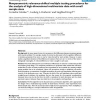15 search results - page 2 / 3 » Step-Down FDR Procedures for Large Numbers of Hypotheses |
BMCBI
2006
13 years 9 months ago
2006
Background: A large number of genes usually show differential expressions in a microarray experiment with two types of tissues, and the p-values of a proper statistical test are o...
BMCBI
2005
13 years 9 months ago
2005
Background: The evaluation of statistical significance has become a critical process in identifying differentially expressed genes in microarray studies. Classical p-value adjustm...
BMCBI
2008
13 years 10 months ago
2008
Background: In many research areas it is necessary to find differences between treatment groups with several variables. For example, studies of microarray data seek to find a sign...
RECOMB
2010
Springer
13 years 11 months ago
2010
Springer
Abstract. Recent genome sequencing studies have shown that the somatic mutations that drive cancer development are distributed across a large number of genes. This mutational heter...
HIS
2004
13 years 11 months ago
2004
Boosting is a general method for improving the accuracy of a learning algorithm. AdaBoost, short form for Adaptive Boosting method, consists of repeated use of a weak or a base le...

